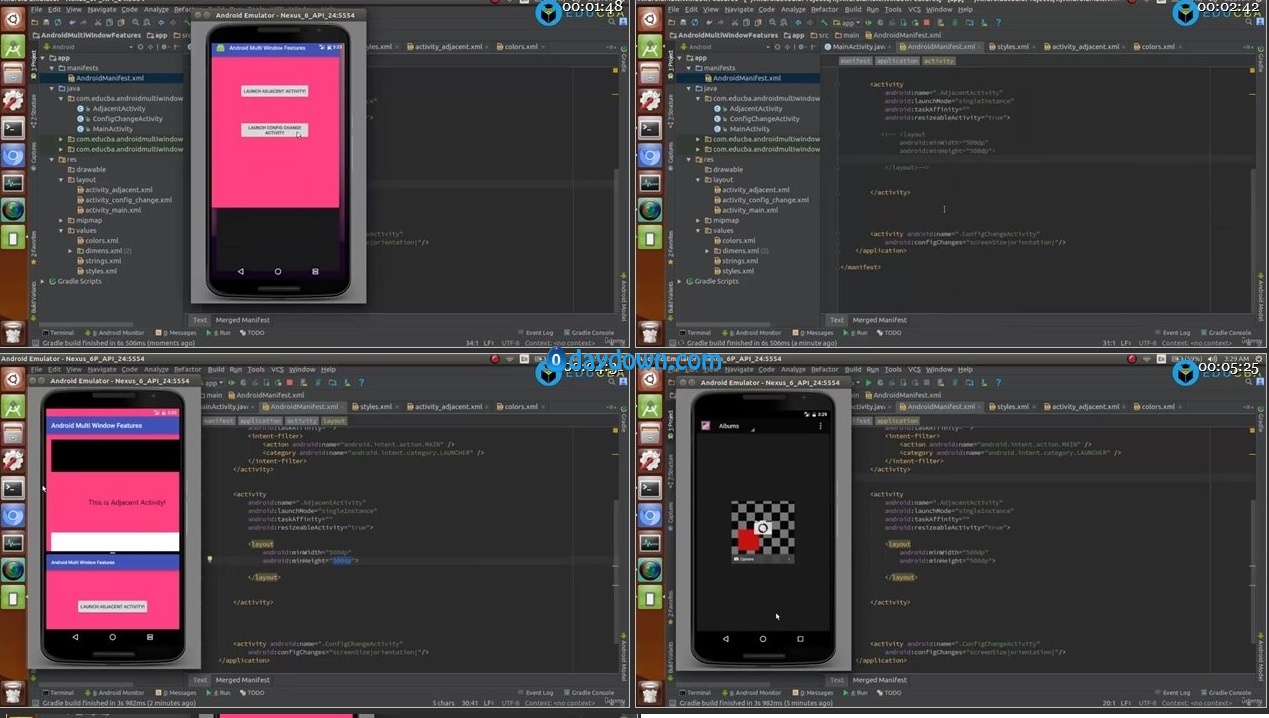
Published 06/2022
Genre: eLearning | MP4 | Video: h264, 1280×720 | Audio: AAC, 44.1 KHz
Language: English | Size: 1.76 GB | Duration: 28 lectures • 3h 48m
Learn to set up Android Studio for building android N applications and develop amazing apps
What you’ll learn
Learn Multi-Window Support, Detecting Multi-Window Mode, Undesirable Activities
Learn about Direct Reply from Notifications, Direct Boot Notifications Enhancements
Learn about Multi-Window Support, Install and Settings
Learn about Picture Mode, Drag and Drop, Demo Scoped, Directory Access
Requirements
Each course has a pre-requisite and the same is kept ensuring a smooth learning curve for the students. Learning Android is not very difficult and hence the pre-requisites are not very hard to maintain. Someone who has working-level Java skills and has done some Android coding before should be fine to learn the concepts of this Android Nougat Tutorial. Detailed pre-requite is described below: Below are some of the pre-requisite for this course: – Before starting the course on Android, it is recommended that you must have sound knowledge on Java as most of the coding will be on Java. You need not be an expert programmer in Java but should at least know the concepts such as OOPs, multi-threading programming, exception handling, collections, etc. A computer or a laptop with an internet connection and basic software required for Android.
Description
Android N short for Android Nougat is the seventh major version and the 14th overall original version of the Android operating system. It was first released on March 9, 2016, as an alpha test version. The official release took place on August 22, 2016. Nexus smartphone devices from Google was the first to receive the update. The LG V20 was the first smartphone that was released with Nougat OS in the market. Nougat introduced many notable changes to the Android operating system space including the ability to split-screen and display multiple apps on-screen at once, support for quick inline replies to notifications, and an expanded power-saving mode to save power by restricting device functionality once the screen has been off for some time. Additionally, the OS platform also switched to an OpenJDK-based Java environment and got support for the Vulcan graphics rendering API.
Some important upgrades on Android Nougat are as below
Split Screen Mode
Quick Switch
Secret UI tuner
Easy pull-down shade editing
Power notification
Easy notification editing
Set a separate wallpaper for lock and home screen
Display size
Easter Egg
The major learning outcome has been outlined in the section above. Still, we provide the details here to explain this more clearly. Nougat was released containing many important aspects of Android development and the same are the main skills that the student will obtain through this course. It is expected that the students are already aware of core Android OS and the basics of what was released in the earlier versions. In a nutshell, users will learn the following skills from this Android Nougat Tutorial : –
Multi-Window Support
Detecting Multi-Window Mode
Undesirable Activities
Picture Mode
Drag and Drop Demo
Scoped Directory Access
Direct Reply from Notifications
Direct Boot
Notifications Enhancements
Multi-Window Support
Install and Settings
Who this course is for
The Java Nougat Tutorial is suitable for a wide range of people who finds themselves associated with the app development ecosystem or information technology in general. Students, working professionals, Consultants and startup evangelist all are welcome to take this Android Nougat Tutorial. Generally, people with BTech, BCA, BSc, MCA, MTech or MS degree enroll for this course. Both any particular educational qualification or certification is not mandatory for it and practically anyone who knows a little bit of coding and is enthusiastic about app development could take this course. Still, we provide a suitable target audience list for our readers.
 Password/解压密码www.tbtos.com
Password/解压密码www.tbtos.com